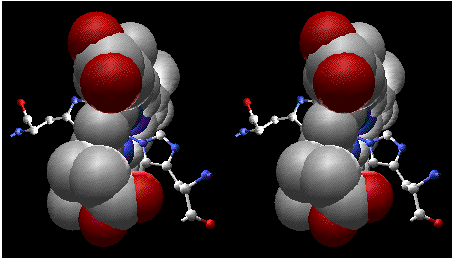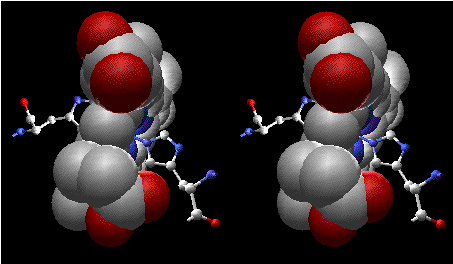Stereo Viewing
"... the best introduction to stereo viewing on the web ...
"
(RasMol Home Page: What's
New? 97/09/14)
Gale Rhodes
Contact Information

Dom
St. Stephan, Passau, Deutschland
(convergent stereo)
The sky at night, a loon's call,
autumn's first apple, a
spider's web,
a crystal, a protein's core—
my life is full of cathedrals.
Too often, people try only briefly and
halfheartedly to view in stereo, and never try again. Almost anyone
can view in stereo with a little effort and practice. The only ones
who simply cannot are those who have acute amblyopia (one very weak
eye). And those who say they can see just as much without stereo
simply cannot imagine what they are missing. You can be a much more
effective explorer of molecular structure if you learn to see in 3D.
Most structural biologists learn to view stereo views by two methods:
convergent and divergent viewing.
Viewing In 3D On A Computer
Monitor Or Classroom Screen
First turn on stereo viewing with your molecular
graphics program. For most graphics programs, set the stereo viewing
angle to -5 degrees (that's minus five). RasMol is backwards;
for convergent viewing, set the angle to 5 degrees with the command
stereo 5 (this is the default in RasMol).
Or work with this convergent stereo pair of the
heme (space filling) and histidine ligands (ball and stick) in
cytochrome
b5*:

How To Do It
To view most computer and projected
stereo images, you need to look at the left-hand image with your
right eye, and at the right-hand image with your left eye (called
convergent or cross-eye viewing). Here's how to develop the skill at
your computer.
Gaze at the stereo pair, keeping your eyes level
(don't tilt your head left or right), and cross your eyes slightly.
As you know, crossing your eyes makes you see double, so you will see
four images. Try to cross your eyes slowly, so that the two images in
the center come together. When they converge or fuse,
you will see them as a single 3D image. The fused image will appear
to lie between two flat images, which you should ignore. When you are
viewing correctly, you see three images instead of four. The center
image is three-dimensional. At first, the 3D image may be blurred.
Keep trying to hold the stereo pair together while you focus. The
longer you can hold it, the more time your eyes have to adjust their
focus. Usually, even before you begin to get the hang of focusing,
the two central images lock together, because your mind begins to
interpret them as a single 3D object.
Having trouble? Here's another approach. With your
head level and about 2.5 feet from the screen, hold up a finger, with
its tip about 6 inches in front of your face, and centered between
the stereo pair on the screen. Focus on your finger tip. Without
focusing on the screen, notice how many images you see there (they
will be blurred). If you see four images, move your finger slowly
toward or away from you eyes, keeping focused on your finger tip,
until the middle pair of images converge. With your finger still in
place, partly covering the converged pair, change your focus to the
screen. The image partly hidden by your finger should appear
three-dimensional. Your finger should still appear single, but
blurred. With some practice, you can remove your finger and still
keep the screen images converged into a stereo image.
Now try your skill with the stereo image at the
top of this page. If you are viewing properly, the golden hangings at
the right should look much closer to you than the high vaults of the
cathedral interior.
Viewing Stereo Pairs In Texts And
Journals
These instructions are for a printed stereo pair,
which you can find in some biochemistry textbooks or in journal
articles (try a recent issue of Science -- look for an article
announcing a new protein structure determination).
If you have no printed pairs, print this page with
a color printer, and use this divergent version of the previous
stereo
pair*:

If you can't print the image, use it on the
screen, or use your molecular graphics program to make a satisfactory
image. First, turn on stereo viewing. Shrink the graphics window so
that the stereo pair is small -- about the same size as a stereo pair
in a textbook. The distance between image centers must be no more
than the distance between your eyes, 6 to 7 cm (for those still in
the Dark Ages, that's about 2 & 1/2 inches). For divergent
viewing in most graphics programs, set the stereo angle to 5 degrees
(that's plus five -- this is often the default setting).
RasMol is backwards; for divergent viewing, set the RasMol stereo
angle to -5 degrees (thats minus five) with the command
stereo -5.
How To Do It
To view most printed images, you need to view the
left image with the left eye, and the right image with the right eye
(called divergent or wall-eye viewing). Here are two methods to
try.
Put your nose on the page between the two views.
With both eyes open, you will see the two images superimposed, but
out of focus, because they are too close to your eyes. Slowly move
the paper away from your face, trying to keep the images superimposed
until you can focus on them. (Keep the line between image centers
parallel to the line between your eyes.) When you can focus, you will
see three images. The middle one should exhibit convincing depth. Try
to ignore the flat images on either side.
Another method -- the one I used when stereo pairs
first appeared in the biochemical literature (can anyone tell me
where?): Photocopy a stereo pair from a text or journal article, and
cut off the copied page above the pair, leaving the pair at the very
top of the page. Then hold the page just below eye level, and look
out above it at a distant object. You will notice below your line of
sight that the two views are blurred, but superimposed on each other,
because your eyes are looking more or less parallel to each other to
the distant object. Now move the picture upward into your line of
sight, trying to keep the images superimposed, and try to focus on
them. As with the first method, you will see three images -- the
middle one is three-dimensional.
Here's another technique, suggested by Nicolas
Guex.
Tape a divergent stereo pair to a mirror, just
below eye level. Then look at your eyes in the mirror above the
image. Slowly bend your knees so that your view passes through the
stereo pair on the way to looking at your eyes below the image, and
then slowly rise again and repeat. At some point, as you cross the
pair, the images should fuse, and you should find it easy to focus on
the three-dimensional image, because your point of focus for looking
at your reflection is not far off.
Finally, try this suggestion from Mitchell Miller
of MDL Information Systems.
Use two empty paper-towel or bathroom-tissue rolls
like binoculars. Point left roll at left view, and right at right.
This should allow comfortable 3D viewing. Then see if you can quickly
remove the rolls and keep the views converged.
(In trying for divergent viewing, you may stumble
into convergent viewing; after all, it's actually a more natural
thing for your eyes to do. With the image above, if you mistakenly
view it cross-eyed instead of wall-eyed, it will appear very strange
because the depth cues of the image (light, shadow, and hidden
surfaces) conflict with those provided by the double image. In
addition, the space-filling heme atoms will appear to be inside out,
or concave rather than convex. Finally, the histidines (ball and
stick) will appear closer to you than the front edge of the heme,
while they are actually near the middle of the heme.)
Practice, Practice, Practice
Viewing either convergently or divergently becomes
easier with practice. Once your mind sees a pair as a single 3D
image, it recalls the experience, and resists your efforts less with
each try. I can automatically snap a stereo pair -- convergent or
divergent -- into superimposition, and I no longer think about
exactly what I am doing. Suddenly, there is a vivid,
three-dimensional object floating above the screen or page. I've been
doing it since 1969 (that's a hint about the source of the first
biochemical stereos!), and I've suffered no damage to my vision. It's
very handy to be able to use the stereo pairs in Science and
other journals without digging up a viewer. Such important tasks as
interpreting electron-density maps from x-ray crystallography are
practically impossible without this skill.
* Stereo images prepared with
SwissPdbViewer (well, all but one).
To The Molecular Level
You are visitor number



